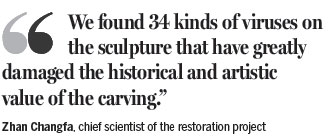|
|
Problems created by water seepage, weather corrected by four-year conservation project
After four years of restoration, the Thousand-Hand Goddess of Mercy statue, which is regarded as the jewel of the Dazu Rock Carvings in Chongqing, will reopen to the public next month.
A team of heritage preservation experts inspected the work on Wednesday and announced that the project was complete.
"This repair work has tackled a series of technical challenges to preserve the cultural relic with modern scientific technologies and new materials to ensure the authenticity and integrity of the statue," said Huang Kezhong, the leader of the State Administration of Cultural Heritage Inspection Team.
The team has also suggested the local government should repair the Great Mercy Pavilion, which houses the statue, as soon as possible.
The Dazu Rock Carvings, 60 kilometers west of Chongqing, date to the Song (960-1279) and Ming (1368-1644) dynasties and comprise more than 5,000 statues. They were opened to Chinese visitors in 1961 and foreign visitors in 1980.
The carvings were listed as a UNESCO World Heritage Site in 1999.
"They are remarkable for their aesthetic quality, their rich diversity of subject matter, secular and religious, and the light that they shed on everyday life during this period. They provide outstanding evidence of the harmonious synthesis of Buddhism, Taoism and Confucianism," the citation said.
The statue of Kwan-yin in Baoding Mountain was carved about 800 years ago during the South Song Dynasty (1127-1276), with 830 hands in an area of 88 square meters in the hillside. It is 7.7 meters tall and 12.5 meters wide, featuring color painting and gold foil. It is the largest of its kind in China.
Water seepage and weather damage caused the statue to deteriorate, and a conservation project began in April 2011. It was listed as the top restoration project by the State Administration of Cultural Heritage. The work was led by the China Cultural Heritage Protection Research Institute. Experts from Dunhuang Research Academy, the Academy of Dazu Rock Carving, Peking University, Tsinghua University and China University of Geosciences also participated.
Three phases
The project went through three phases from inspection, planning and the actual repair work.
The team used X-ray and 3-D laser scanning to collect information needed to effect the restoration.
"We found 34 kinds of viruses on the sculpture that have greatly damaged the historical and artistic value of the carving," said Zhan Changfa, the chief scientist of the restoration project.
They also found that 283 of the statue's 830 hands and arms were damaged. To respect the religious history, the team consulted reference books and pictures to ensure the restoration was accurate.
The major part of the restoration involved attaching a new layer of gold foil to the statue. The original foil was between 83 percent and 92 percent gold. In some parts the statue had six layers of gold foil as a result of restoration work in the past.
An ancient technique from the Song Dynasty was applied. The gold foil was first separated from the statue, washed in pure water and alcohol before being reapplied. Once in place, it was painted with three coats of lacquer.
The statue is due to reopen to the public on June 13, which is China's Cultural Heritage Day.
tanyingzi@chinadaily.com.cn

